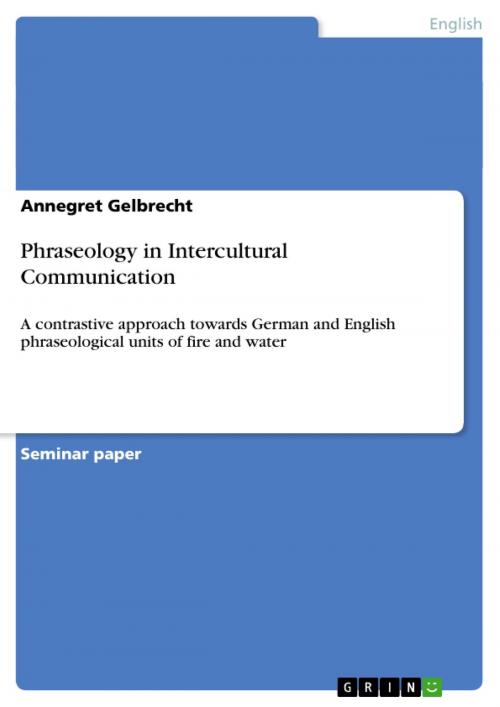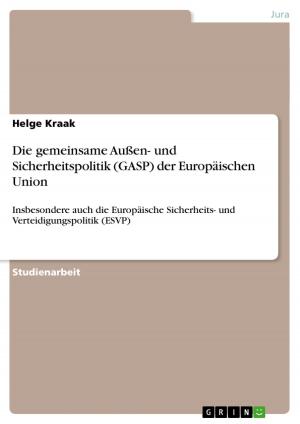Phraseology in Intercultural Communication
A contrastive approach towards German and English phraseological units of fire and water
Nonfiction, Entertainment, Drama, Anthologies| Author: | Annegret Gelbrecht | ISBN: | 9783640963065 |
| Publisher: | GRIN Publishing | Publication: | July 20, 2011 |
| Imprint: | GRIN Publishing | Language: | English |
| Author: | Annegret Gelbrecht |
| ISBN: | 9783640963065 |
| Publisher: | GRIN Publishing |
| Publication: | July 20, 2011 |
| Imprint: | GRIN Publishing |
| Language: | English |
Seminar paper from the year 2011 in the subject English Language and Literature Studies - Linguistics, grade: 1,7, University of Erfurt (Philosophische Fakultät - Fachbereich Anglistik), course: Intercultural Communications, language: English, abstract: 'Idioms, the colourful side of languages, are one of the symbols used while we are communicating our thoughts and feelings. They are used to give life and richness to the language by taking the existing words, combining them in a new sense, and creating new meanings, just like a work of art.' (LEN-NON, 1998, cited in BULUT; ÇELIK-YAZICI, 2004: 105) This combination of existing words 'like a work of art' represents a huge challenge for non-native speakers they have to cope with in their language learning process. In the context of intercultural communication, non-native and native speakers interact with each other and often make use of idioms and other fixed expressions as 'the colourful side of languages', because they are used to it from their usual communication in their first languages. However, these fixed expressions constitute a special part of the language use due to particular characteristics, which will be explored further in this term paper. Consequently, communication between non-native and native speakers does not always runs smoothly when phraseological language comes into play. Amongst others, the cultural boundedness as well as native-like creative exploitations of the fixed expressions represent probable causes for misunderstandings. These aspects will be presented hereafter. Given the limited space of this term paper, the focus is on communication between non-native and native speakers. Phenomenon connected to the phraseological language in a lingua franca setting cannot be examined further. Within the scope of intercultural communication, contrastive linguistics is one approach towards interactions across language borders. 'Contrastive linguistics focuses on pairs of languages and explores similarities and differences between them.' (KRZESZOWSKI, 1991: 10) In the tradition of contrastive linguistics, the second part of this term paper focuses on the contrastive description of the phraseological language of two different languages, namely German and English. The collection of phraseological units (PUs) is narrowed down to facilitate the comparison. PUs, whose source domain originates either from the concept 'FIRE' or from the concept 'WATER', are chosen for this comparison. However, in order to set the frame for the examination of different PUs, it is important to look at some theoretical foundations on the topic of phraseological language first.
Seminar paper from the year 2011 in the subject English Language and Literature Studies - Linguistics, grade: 1,7, University of Erfurt (Philosophische Fakultät - Fachbereich Anglistik), course: Intercultural Communications, language: English, abstract: 'Idioms, the colourful side of languages, are one of the symbols used while we are communicating our thoughts and feelings. They are used to give life and richness to the language by taking the existing words, combining them in a new sense, and creating new meanings, just like a work of art.' (LEN-NON, 1998, cited in BULUT; ÇELIK-YAZICI, 2004: 105) This combination of existing words 'like a work of art' represents a huge challenge for non-native speakers they have to cope with in their language learning process. In the context of intercultural communication, non-native and native speakers interact with each other and often make use of idioms and other fixed expressions as 'the colourful side of languages', because they are used to it from their usual communication in their first languages. However, these fixed expressions constitute a special part of the language use due to particular characteristics, which will be explored further in this term paper. Consequently, communication between non-native and native speakers does not always runs smoothly when phraseological language comes into play. Amongst others, the cultural boundedness as well as native-like creative exploitations of the fixed expressions represent probable causes for misunderstandings. These aspects will be presented hereafter. Given the limited space of this term paper, the focus is on communication between non-native and native speakers. Phenomenon connected to the phraseological language in a lingua franca setting cannot be examined further. Within the scope of intercultural communication, contrastive linguistics is one approach towards interactions across language borders. 'Contrastive linguistics focuses on pairs of languages and explores similarities and differences between them.' (KRZESZOWSKI, 1991: 10) In the tradition of contrastive linguistics, the second part of this term paper focuses on the contrastive description of the phraseological language of two different languages, namely German and English. The collection of phraseological units (PUs) is narrowed down to facilitate the comparison. PUs, whose source domain originates either from the concept 'FIRE' or from the concept 'WATER', are chosen for this comparison. However, in order to set the frame for the examination of different PUs, it is important to look at some theoretical foundations on the topic of phraseological language first.















